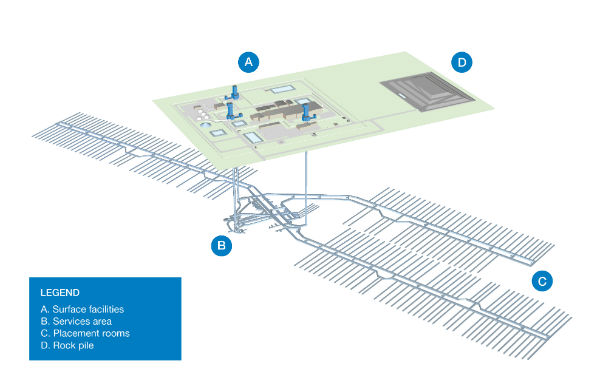 Canada's Nuclear Waste Management Organisation (NWMO) expects to select a single, preferred site for a deep geological repository for used nuclear fuel by 2023, according to its latest Triennial Report from 2017 to 2019.
Canada's Nuclear Waste Management Organisation (NWMO) expects to select a single, preferred site for a deep geological repository for used nuclear fuel by 2023, according to its latest Triennial Report from 2017 to 2019.
The report, Moving towards partnership – Triennial Report 2017 to 2019, meets a requirement of Canada's Nuclear Fuel Waste Act (NWFA) and will be tabled in Parliament.
In the report, the NWMO notes that during the reporting period, the organisation reduced potential host repository sites from nine in 2017 to two in 2019.
Of the 21 communities that initially requested preliminary assessments for possible sites, two – Huron-Kinloss and South Bruce in southern Ontario and Ignace in north-western Ontario – remain under consideration as potential host areas.
"Throughout this reporting period, bold steps are evident in all our work – in advancing site selection, in validating our technical solutions, and in leading by example with our Reconciliation journey," said NWMO president and CEO Laurie Swami.
A new five-year strategic plan, Implementing Adaptive Phased Management 2020 to 2024, forms part of the Triennial Report, setting out piorities for 2023 and beyond.
From 2020-2024 the NWMO will complete the process of identifying a single preferred site and move into the licensing and regulatory process.
Activities will include completing the design, fabrication, and testing of prototype repository containers, buffer, and emplacement systems, as well as maintinating a prototype test facility to evaluage the engineering barrier concept.
Following site selection in 2023, the NWMO estimates that a site licence would be granted in 2026, and a construction licence in 2032. Design and construction would begin in 2033 ready for the repository to enter operation between 2040 and 2045.
Cost of Canada's nuclear waste management plan
The report estimated the total lifecycle cost of Canada’s plan – from the start of site selection in 2010 to the completion of the project – is approximately CAD23 billion ($16.4bn) over the course of a 150-year timeline. This is based on an expected volume of 5.2 million fuel bundles.
“This figure covers many decades of lifecycle activity – stretching well into the next century. That does not mean, however, that we need $23 billion today," NWMO said. "Instead, we must calculate how much money needs to be in trust today so that it can continue to generate enough income over time to cover the costs of Canada’s plan.”
The NWMO estimated that the funding required to manage 5.2 million bundles from 2020 onwards would be CAD9.6 billion – “a sum that will grow and compound as the project advances."
Of this, some CAD2.8 billion is needed for work to select a site for the repository, complete detailed design, develop the Centre of Expertise, acquire the site, evaluate environmental impacts, and obtain a site preparation and construction licence.
Following site selection, NWMO will launch the preliminary design for a
deep geological repository.
The NWMO's response to COVID-19
NWMO also said recently that, like other organisations in Canada and around the world, it “is taking steps to help flatten the curve of the COVID-19 pandemic, and contribute to the health and well-being of our colleagues and the communities where we are active”.
Steps have been taken to cancel training, conferences, events, and most travel as well as to limit face-to-face meetings, using teleconference and video conference, wherever possible.
Technical site evaluations, such as borehole drilling, have been paused and will resume at a later date. Employees are encouraged to work remotely, and community offices in Ignace and both South Bruce and Huron-Kinloss have been closed.
Photo: Proposed layout of Canada's deep geological repository for used nuclear fuel (Credit: NWMO)






